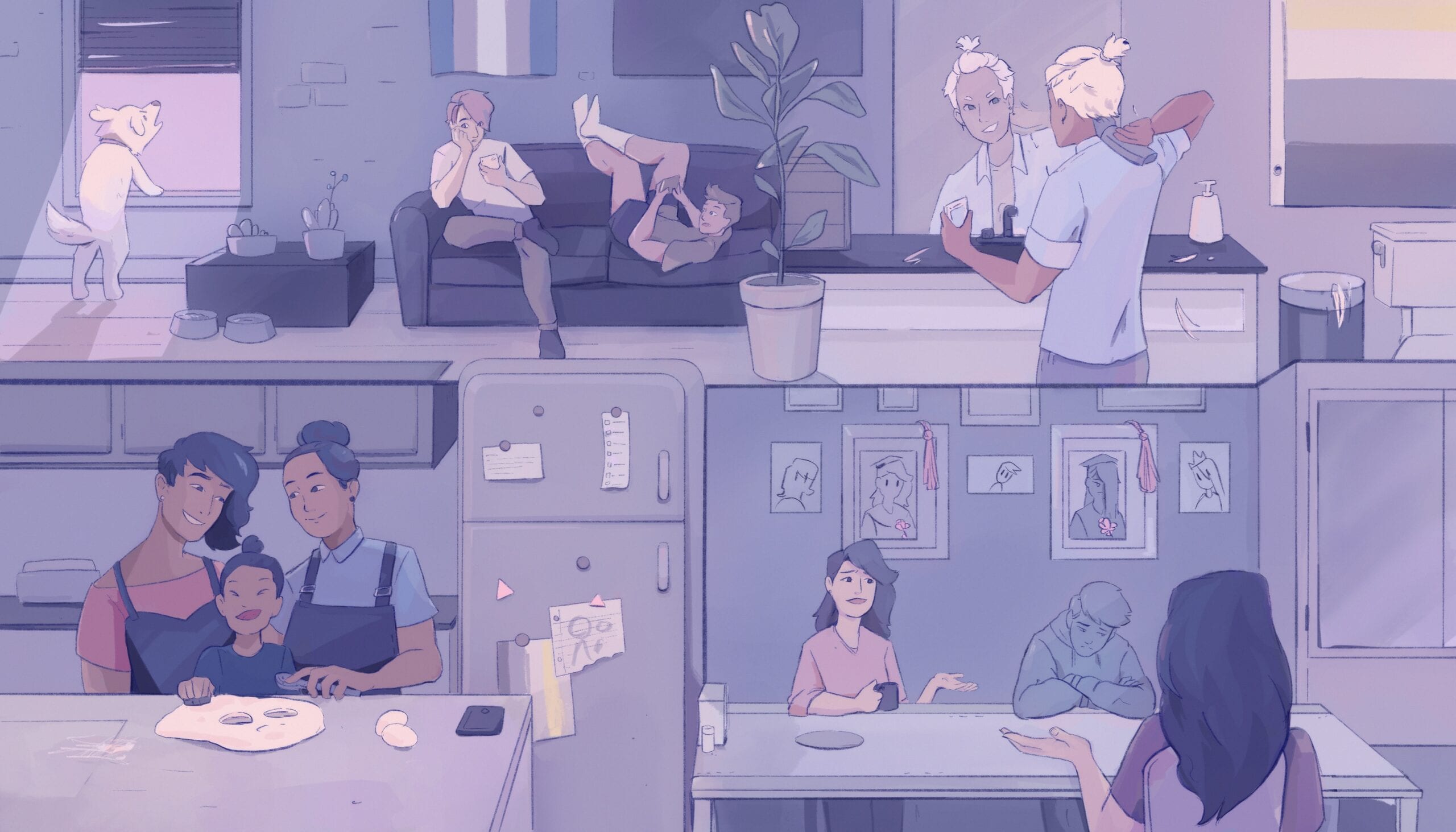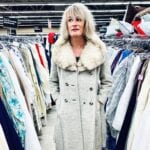For trans and non-binary folks, the isolation measures set in place around the world during the COVID-19 pandemic have made life difficult: Everyday microaggressions and obstacles have been amplified, access to life-saving resources is often cut short and physical supports are often out of reach. As our lives shift to adapt to this new reality, made up of physical distancing regulations and Zoom coffee catch-ups, Xtra asked four trans and non-binary folks across the globe to tell us what isolation is like for them. For some, it’s filled with new beginnings. For others, it’s a time to reflect, to more deeply come to understand who they are. But for all of them, it’s an opportunity to show the world the ups and downs of trans life in quarantine.
In quarantine, I’m learning how to be trans—without the fear of being misgendered
Since I graduated from university in Oxford, England, last summer and started working as a bookseller, I’ve taken on a morning routine: I get dressed, I look in the mirror and I weigh my chances of giving people pause. Do I go for masculine clothes, which tend to make people hesitate before calling me “ma’am” but can attract unwanted attention? Do I settle for baggy clothes that hide my chest but make me feel dull and uninspired? Or do I use a binder and risk being trapped at the till when I need to take it off? Will that small, bright touch—a bow, an earring, a coloured band—throw off any sense of ambiguity, making me look too female? Maybe this work would make sense if it helped to avoid being misgendered, but it doesn’t. Since I’m non-binary, I get misgendered no matter what I wear because most people cannot see me as anything other than male or female. That’s not to say that changing my appearance doesn’t produce different results—it’s fascinating seeing people’s faces change when they hear my voice—but I’m doing this work because I feel like I have to. In order to be a Good Trans Person, so the gospel says, you have to try. You have to constantly calibrate your presentation, and in return, you get to feel justly hard done by the next time you get glared at in the women’s bathroom. But now, I’m free! Everyone’s gone home! I don’t feel like I’m under a microscope all the time! And yet, I’m not sure how to be non-binary without this daily rigmarole. Is making cis people confused about my assigned gender really the only goal I’m allowed to have? I hope not, but sometimes it’s hard to think in any other terms.
Dani Cugini shares their pandemic wardrobe
Isolation is a strange place for trans people. Materially, it’s terrible—trans people are disproportionately poor and precariously employed, and need vital access to medical services. But it also grants us the kind of mental freedom that we almost never get in normal life. We’ve been taught to think of ourselves in cis people’s terms our whole lives, and it’s easy to get trapped in that. But in isolation, the demands to conform to cisness feel further off, and our own thoughts and desires are closer and clearer. In fact, I know of many people who have realized they’re trans during this COVID-19 quarantine, and it seems as though isolation catalyzes that. I would know—it happened to me. Last year, I was 21, doing a master’s in English and was immensely stressed. I’d made some laconic pronouncements at one point about maybe being the wrong gender, but had quickly bottled them up, unable to cope with them along with everything else. While I was self-isolating to write my thesis, I impulsively got up from writing one night, cut all my hair off, texted a photo to my boyfriend, scooped a pound of hair into the bin and went to sleep. A few weeks later, I was out as non-binary.
“Isolation helped me grow from a gibbering mess of denial to, in some small sense, an activist”
In hindsight, it was laughably obvious that whole year that something was up gender-wise: I spent so much time pressing my breasts down in the mirror and obsessively examining my own face. But I needed to ease away the mental barriers I’d built, and that’s much harder to do when you’re swept up in the flow of normal life. Digging up gendered assumptions that are planted deep in your head is exhausting, and I needed my life to be paused, or displaced, in order to have space to do that work. Realizing that you’re trans can be a bit like realizing you need to break up with a long-term partner. You know, on a bone-deep level, that something has to change; but if you sit there dwelling on all the pain it’s going to cause, or try to incorporate every single piece of wisdom that the various people in your life have given you, it’s easy to get overwhelmed and end up clinging to the status quo like a safety blanket. I needed time by myself to know that it was okay and necessary to do what I was doing. You need that time if you’re trans, because you have to trust your convictions in the face of people who think your identity is some combination of impossible and degenerate. Isolation helped me grow from a gibbering mess of denial to, in some small sense, an activist. Still, I don’t want to think of the current quarantine as blithely restorative—not when my mother and brother are both essential workers, and any extra rest I’m getting is mostly offset by worrying about them. Quarantine isn’t freedom; it’s more like being suspended. I don’t have a therapist—the ones I contacted aren’t taking clients. And though I’m not currently seeking hormones or surgery, their inaccessibility still feels anxiety-inducing. I’m stuck rotating between the same three collared flannels and shapeless jumpers. And, as the barber who cleaned me up the morning after I chopped all of my hair off can attest, I’m not exactly a talented DIY hairdresser. I don’t have the tools to thrive here. In the least, I’m making do. I’m doing my best to feel connected to other queer and trans people: I’ve written a queer literature quiz, I’ve spent too much time on non-binary Twitter and I’m taking time to read some important trans and genderqueer authors, like Leslie Feinberg, Akwaeke Emezi and Susan Stryker. That helps give purpose to this whole thing.
“Away from the constant scrutiny, it’s much easier to think of my gender as okay, even good, and to stop feeling so guilty and burdened”
It’s hard to motivate myself to play around with my aesthetic, though. I’ve tried, in a self-care kind of way—playing around with colourful eyeshadow, pulling stuff out of my wardrobe, taking photographs. But the pandemic has made me lose most of my usual interest in how I look. If nothing else, there’s a lot to be said for this quietness. I’m used to thinking of my genderqueerness as either something I have to constantly fight cis people for, or as something awful and destructive that’s going to ruin my life, ruin my partner’s life by depriving him of a “normal” partner and make everything scary and terrible. In this flat, away from the constant scrutiny, it’s much easier to think of my gender as okay, even good, and to stop feeling so guilty and burdened. It’ll take time, but it feels closer here. I might as well take the chance to prioritize myself for a while, until it’s time to be back in the world again. Maybe I’ll finally dye my hair. —Dani Cugini

I don’t have to perform my gender for anyone but me during isolation
My alarm goes off and I stay in bed. I sleep with my window open, and as the sun peeks through the blinds, I close my eyes and feel the breeze on my face. In exactly 30 minutes, my second alarm will ring—the “now-you-have-to-get-up” alarm. I’ll force myself out of bed and into the shower. I’ll forget to wash my hair and wrap myself in a towel that’s still damp. Then I’ll go downstairs, pour what’s left from yesterday’s coffee over ice and pretend I’m having a cheeky exchange with a tattooed barista in a bootlegged Cramps shirt. “This is Quarantine,” I think to myself. “By David Foster Wallasshole.” I mentally prepare for working at home, but I don’t “get ready” for the day the way I used to. I don’t stand in front of my closet, questioning what version of myself I want to show the world. I don’t try on five outfits, hate them all and then get sweaty and patchy from being anxious. Weeks into quarantine here in Philadelphia, with no social interactions lined up and no one looking at me, I feel no desire to get dressed at all. I feel no need to contain or express or present. No need to perform. No need to put my round body into my rough jeans. I wonder why I was ever comfortable with being uncomfortable. Before this pandemic hit, I used to dread the weather changing. It took me a whole season, it seemed, to learn how to feel comfortable dressing. And when I finally figured out the shoes that made me feel like I wasn’t going to die, the pants that made me want to escape my body a little less, suddenly the weather was completely different and I had to start from scratch. My first year of over-priced liberal arts college, I learned the terms and words that helped me describe this feeling to others. Identifying as non-binary meant an existence outside the excrutiating limitations of gender, denying that gender was anything more than a social construct. Wearing certain clothes or cutting my hair a certain way showed the world who I was. I felt a sense of control in what I presented.
“I’m letting the soft animal of my body just love what it loves—without fear of looking lazy or sloppy or feminine or masculine”
But this spring is different. The weather is warmer, but I am not going outside. I am not riding the bus to another part of the city. I am not passing strangers on the street. I am not talking to a hot barista in a cool T-shirt. I am not being seen or acknowledged or interpreted by anyone. Instead, I’ve been staying in my pajamas all day—loose-fitting cottons that billow when the windows are open in the kitchen. I make coffee in my bare feet and I scrunch my toes when I step onto a cold tile in the shade of the refrigerator. I wear the clothes I used to change into when I came home after a long day out—the clothes I never wanted to wear outside, that make me feel rested, gentle: a pair of black Puma sweatpants I stole from my dad last Christmas, a worn-in crewneck sweatshirt from a high school I didn’t go to, a T-shirt from a band I never really liked.
Griffin Wynne on their pandemic morning routine
As American poet Mary Oliver would say, I’m letting the soft animal of my body just love what it loves—without fear of looking lazy or sloppy or feminine or masculine. I’m growing comfortable with being comfortable. Having spent countless days in isolation, I can’t stop thinking about that cheesy philosophical quandary about a tree falling in the forest. Like a stoner undergrad who just learned about Platonism, I picture myself asking: Does a sound need to be heard for it to be a sound? What is noise when no one is there to hear it? American philosopher and queer theorist Judith Butler pioneered the idea that gender is performative. Though we’ve been taught that gender is an internal reality, it’s nothing more than a set of societal expectations that are constantly regulated and policed by the outside world. I’ve agreed with this sentiment long before I knew who Butler was, long before I knew how to talk about my own identity. From childhood, I felt like gender was something I had to perform. But what is performance without an audience? Like a tree falling in the forest with no one around, how much of something is dependent on how it’s received? In queerer words: What gender am I when no one is around? Growing up in a preppy small town in Massachusetts, I was told the things I did or the way I dressed were for attention or to “stand out.” I wanted to be the tree that made noise when it fell. On darker days, I wonder if me being non-binary is just that: A ploy for a attention, a way to make myself be seen as different, special. A way to be heard. And yet, here I am alone—and still I feel void of gender. I stand naked in the mirror to look at myself, without labelling or naming my body parts. I cook and dance and bleach-dye things in my bathtub without thinking about what my pronouns are. I take out the trash and consider writing a memoir about all the idiots I’ve dated without thinking about the gendered connotations.
“I’m not non-binary because others see me that way—I’m non-binary just because I am”
It’s clear that, for me, being a genderless person isn’t about looking or dressing or even acting a certain way—it’s just about exisiting. It isn’t about actively rejecting societal ideas of gender, but merely existing without them. It’s not about performing; it’s about relinquishing. I’m not non-binary because others see me that way—I’m non-binary just because I am. Amid my usual pandemic morning routine, my roommate’s dog howls at an ambulance siren going by and I think about taking a video to send to a friend. But by the time I get my phone, the truck is gone and the dog is back to lying in the sunny spot of the living room. I touch the soft, floppy skin around his neck and bury my nose in it to smell the grass on his fur. I don’t need others to hear him to know for myself that he’s made a sound. —Griffin Wynne
Why I came out as trans during COVID-19
When we isolate, we often find ourselves facing deep personal truths. Enforced solitude can leave us without the connection of our relationships and with nothing but time to look inward and see the truths within us that we’ve kept at bay. For some, this manifests in acts of self-care—an increase in exercise or an intense interest in baking. We can discover a lot about ourselves when we’re given too much time to look in the mirror. While quarantining during the COVID-19 pandemic, I’ve lately been finding myself increasingly looking inward. Self-reflection has propelled me to give form to the truths within me. While the prevailing conversation during the COVID-19 pandemic seems to be about flattening curves, social distancing and surviving isolation, I have been focusing on one simple task: Coming out as transgender to my family, friends, children and loved ones. I’m a librarian in southern Louisiana—not exactly a hotbed for trans communities. I live here with my wife of 10 years and our two kids. Maybe if I had the language earlier, I would have recognized myself as trans at a younger age. As it stands, I really only came to understand my identity about two years ago. For a long time, I felt content to keep this fact to myself, but isolated reflections bring an unavoidable veracity to the surface. My decision to come out was based in part on stress. There are few situations more stressful than being isolated in the midst of a global pandemic, and it can often feel too onerous and exhausting to hide myself amid it all. But I’m also seeing things from a new perspective: I’m lucky. I’m currently healthy, and so is my family—but we might not be for long. For all I know, we might not come out of this. It’s not full-blown nihilism, but it is a realignment of priorities. Do I want people to know me in case there’s not much time left? For the first time the answer, I think, is yes. So, I started coming out to people in a slow trickle. I started by telling my wife, who is my biggest champion. In fact, my coming out has brought us closer together than ever before. Her support gave me the confidence to tell my family. I came out to my sister first, on the phone. She was immediately supportive and encouraging. She thanked me for trusting her enough to tell her. “I can’t imagine anyone giving you shit over this when people are literally falling down dead all over the world,” she told me. It was enough to affirm me and encourage me to tell the rest of my family. I added my new pronouns—they/them—to my work email signature. I even drunkenly texted some of my friends about it. So far, the response has been overwhelmingly positive—so much so that there’s not much space for negativity left.
“Coming out during the pandemic is teaching me a lot of things about myself as well, namely: I’m not fragile and I’m not alone”
But coming out at a distance comes with its own set of challenges. Without body language, we can only take comments at face value. Instead, I claim the small victories: Hearing people use my pronouns sounds like them cheering me on. Over email, people have shown their support for me by also adding their pronouns to their signatures. It’s gone well enough that I’m taking the next steps in my transition. I’ve assembled a care team—a GP, endocrinologist and a therapist—and I’m hoping to start hormones soon. My friends are helping me femme my appearance. I’ve also been trying to make trans friends in my community, limited as that community may be. Coming out has helped me manage the stress of this pandemic more than expected. I’m drawing strength from the folks I’m out to. It’s teaching me a lot of things about myself as well, namely: I’m not fragile and I’m not alone. Relationships aren’t brittle and identities aren’t static. In this time of isolation, I’ve found I’m more connected to my loved ones than ever before. —Anonymous. As told to Niko Stratis
Returning home during the pandemic means facing my ‘old self’ again
My high-school graduation photos hang in the family dining room along with my sister’s. When the photos were printed, my friends and I joked that I didn’t look like myself—I’m wearing so much makeup that I’m unrecognizable. Even back then I had a hard time connecting to that portrait. But now as I transition, I feel even more disconnected. I decided to move back in with my parents on Vancouver Island in March after leaving a precarious roommate situation during the COVID-19 crisis. It’s not all bad: I was so used to my dim basement suite in Vancouver, where I’m studying at university, that I had almost forgotten that a house can have natural sunlight in it. I am blessed to have a relationship with my parents that I can come back to. But their house is still filled with pieces of my “old” self that feel strange to be around while transitioning. Like many family homes, there are photos of me all over the house: In elementary school, at the beach, in my high-school musicals. Most of the old photos of me are intensely gendered. Every time I leave the bathroom dressed in a classic dysphoria hoodie, I’m subjected to a picture of me in a tiara, sash and cowl-neck shirt from my local pageant. In my aforementioned high-school grad photo, I’m holding the ceremonial “lady” roses. These pictures show me how hard I tried to reach the unbearable standard of “small-town girl.” I was always uncomfortable with the seemingly rigid set of rules for what it meant to be a girl. It was like everyone else had been given a manual to follow, and I was constantly falling behind. I thought that if I curled my hair the right way, painted my nails the right colour or wore the right combination of shirt/cardigan/jeans something inside me would finally click and I could just be like everyone else. These photos painfully remind me of how I failed to get it “right” for so long.
“Seeing the old photos reminds me of how I failed to be myself for so long, but not being present in my family’s history makes it feel like I am being erased”
My parents, it seems, predicted how I would feel being surrounded by these portraits that exemplify a “small-town girl.” They have tried to limit the number of pictures of me around the house, and the ones that remain show some accomplishment or milestone of mine, photos that they’ve deemed important. While I appreciate my parents’ effort to make me feel comfortable, there is now a new sense of discomfort: It’s a bit hyperbolic, but in seeing so few pictures of myself I feel like I am not really part of this family, like a stranger in this house. It feels as though I kidnapped some poor girl, and now as a cruel joke I’m making this family pretend that I am their child—a poor imitation of a daughter they once had, a daughter whom they loved enough to take photos of to put on a wall. It opens the door to dark thoughts, the ones we keep ourselves from thinking and can never ask out loud: Are they disappointed? Are they ashamed? Are they just pretending to love me? It’s a catch-22—seeing the old photos reminds me of how I failed to be myself for so long, but not being present in my family’s history makes it feel like I am being erased. “I wish you would replace that photo,” I said to my mom, in reference to the graduation picture, the last time I visited. “When you get your undergraduate photos done, we can change it,” she said.
Thomas O’Donnell on his DIY grad photos
Because of the pandemic, I was unable to take new grad portraits. I was distraught, fearful that I would have to look at my smiling feminine face forever.
“It was meaningful to make the time to take new “important” photos—pictures that reflect who I am and not who I was”
But if transitioning has taught me anything, it’s that I am allowed to take my identity and sense of self-image into my own hands. After I finished my final exams, my mom and I made a day of taking new graduation photos for me, standing by the side of the highway where the nice flowers are, jumping off logs at my local beach and throwing my grad cap in the air. My hair is a little overgrown, and we didn’t have the proper regalia. But it was meaningful to make the time to take new “important” photos—pictures that reflect who I am and not who I was, trying to fit myself into a predetermined mould. My new photo now hangs in the family dining room. I am not wearing any makeup, except for some concealer to cover up my testosterone-induced acne. Over the next months and years, my face will grow more defined. And someday I will probably laugh at this photo, yet again finding it hard to recognize myself. But at least in this portrait I am being authentic, not trying to be someone else. —Thomas O’Donnell
Spot illustrations by Arden Cahill





 Why you can trust Xtra
Why you can trust Xtra


